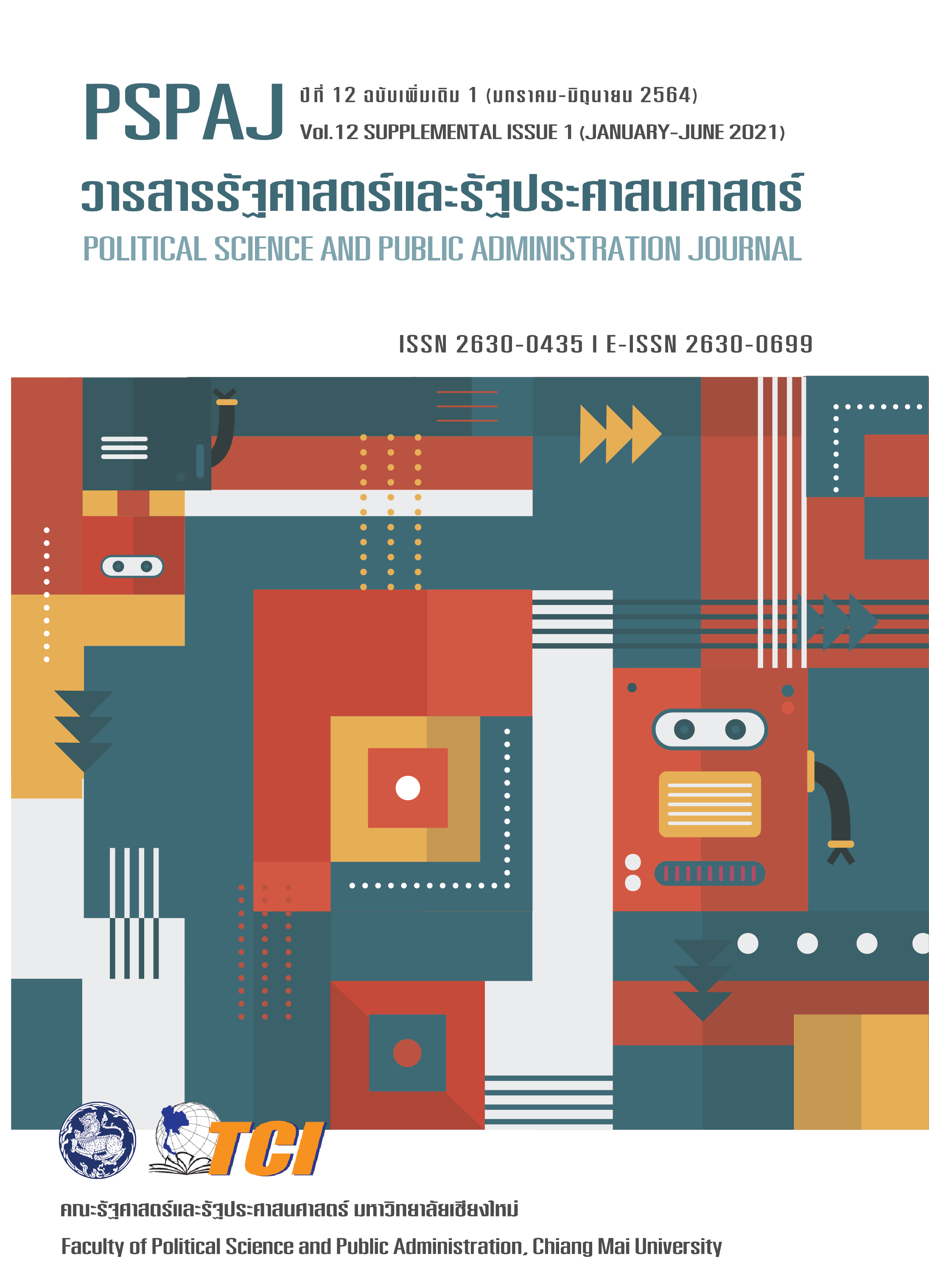การสังเคราะห์บทบาทเมืองอัจฉริยะที่มีผลต่อการลดความเหลื่อมล้ำ ทางสังคม: การสังเคราะห์อภิมาน
Main Article Content
บทคัดย่อ
เมืองอัจฉริยะคือรูปแบบการพัฒนาเมืองโดยการนำเทคโนโลยีมาประยุกต์ใช้ เพื่อช่วยจัดบริการสาธารณะให้กับประชาชนและช่วยอำนวยการบริหารเมือง คนส่วนใหญ่มักเข้าใจว่าเมืองอัจฉริยะมีบทบาทที่เกี่ยวข้องกับประเด็นทางวิทยาศาสตร์ เช่น เทคโนโลยีสารสนเทศ วิศวกรรมศาสตร์ หรือการออกแบบเมือง เป็นต้น อย่างไรก็ตาม เมืองอัจฉริยะยังมีบทบาทที่เกี่ยวข้องในการพัฒนาในมิติด้านอื่นๆ โดยเฉพาะอย่างยิ่งด้านสังคมศาสตร์ บทความนี้มีวัตถุประสงค์เพื่อสังเคราะห์บทบาทของเมืองอัจฉริยะที่มีผลต่อการลดความเหลื่อมล้ำทางสังคม โดยใช้วิธีการสังเคราะห์อภิมาน (Meta-Synthesis) จากฐานข้อมูลทางวิชาการอิเล็กทรอนิกส์ที่เกี่ยวข้องกับสังศมศาสตร์และสหวิทยาการจำนวน 3 ฐานข้อมูล และคัดกรองความเหมาะสมจนได้บทความวิจัยที่ใช้ในการสังเคราะห์ในครั้งนี้จำนวน 10 บทความ ผลการวิจัยแสดงให้เห็นว่าบทบาทของเมืองอัจฉริยะที่มีผลต่อการลดความเหลื่อมล้ำทางสังคม ประกอบด้วย 5 ด้าน คือ 1) การสร้างความเป็นธรรมในการจัดสรรทรัพยากรให้เกิดความทั่วถึง 2) การพัฒนาเมืองและระบบบริหารราชการให้เกิดความโปร่งใส่ 3) การส่งเสริมการประกอบอาชีพและ
สร้างรายได้ 4) การส่งเสริมการสื่อสารและการสร้างการมีส่วนร่วม และ 5) การส่งเสริมความเท่าเทียมกันทางเพศและชนชั้นทางสังคม ดังนั้น อาจจะกล่าวได้ว่าเทคโนโลยีหรือนวัตกรรมที่เข้ามาพัฒนาเมือง จะมีส่วนสำคัญที่ช่วยประชาชนในพื้นที่เมืองให้สามารถรับประโยชน์เท่ากัน รับประโยชน์ร่วมกัน รับบริการเหมือนกัน หรือรับทราบข้อมูลเหมือนกัน โดยไม่มีอุปสรรคแบบเดิมที่ทำให้บริการสาธารณะไม่ไปถึงยังประชาชนหรือไม่เกิดความทั่วถึง
Article Details
- เนื้อหาและข้อมูลที่ลงตีพิมพ์ในวารสารรัฐศาสตร์และรัฐประศาสนศาสตร์ถือเป็นข้อคิดเห็นและความรับผิดชอบของผู้เขียนบทความโดยตรง ซึ่งกองบรรณาธิการวารสารรัฐศาสตร์และรัฐประศาสนศาสตร์ ไม่จำเป็นต้องเห็นด้วย หรือร่วมรับผิดชอบใดๆ
- บทความและข้อมูล ที่ได้รับการตีพิมพ์ในวารสารรัฐศาสตร์และรัฐประศาสนศาสตร์ ถือเป็นลิขสิทธิ์ของวารสาร หากบุคคลหรือหน่วยงานใดต้องการนำข้อมูลไปใช้ประโยชน์ในทางวิชาการ ขอให้อ้างอิงแหล่งที่มาด้วย
เอกสารอ้างอิง
ณัฐวุฒิ อัศวโกวิทวงศ์, ขวัญพร บุนนาค, และนภัส วัฒโนภาส. (2561). ความเหลื่อมล้ำในเมืองมหานคร บทปริทรรศน์ความรู้ในบริบทประเทศไทย. วารสารวิชาการ สิ่งแวดล้อมสรรค์สร้างวินิจฉัย คณะสถาปัตยกรรมศาสตร์ มหาวิทยาลัยขอนแก่น, 17(2), 157-178.
นิติบดี ศุขเจริญ, และวัยวุฑฒ์ อยู่ในศีล. (2557). การวิเคราะห์อภิมานและการสังเคราะห์อภิมาน. วารสารมหาวิทยาลัยราชภัฎมหาสารคาม (มนุษยศาสตร์และสังคมศาสตร์), 8(3), 43-56.
บุญนาค ตีวกุล. (2545). เมืองและสิ่งแวดล้อม. กรุงเทพฯ: คณะศึกษาศาสตร์ มหาวิทยาลัยศิลปากร.
สำนักงานส่งเสริมเศรษฐกิจดิจิทัล. (2563). แผนส่งเสริมการพัฒนาเมืองอัจฉริยะ. สืบค้นเมื่อ 4 กุมภาพันธ์ 2563, จาก https://www.depa.or.th/th/smart-city-plan
Adapa, S. (2018). Indian Smart Cities and Cleaner Production Initiatives-Integrated Framework and Recommendations. Journal of Cleaner Production, 172, 3351-3366.
Ahvenniemi, H., Huovila, A., Pinto-Seppä, I., & Airaksinen, M. (2017). What are the Differences Between Sustainable and Smart Cities? Cities, 60(1), 234-245.
Alizadeh, T. (2017). An Investigation of IBM’s Smarter Cities Challenge: What do Participating Cities Want? Cities, 63, 70-80.
Bansal, N., Mukherjee, M., & Gairola, A. (2017). Smart Cities and Disaster Resilience. In Seta, F, Sen, J., Biswas, A., & Khare, A. (Eds.). From Poverty, Inequality to Smart City (pp. 109-122). Springer Transactions in Civil & Environmental Engineering.
Chourabi, H., Nam, T., Walker, S., Gil-Garcia, J. R., Mellouli, S., Nahon, K., et al. (2012). Understanding Smart Cities: An Integrative Framework. In 2012 45th Hawaii International Conference on System Sciences. (pp. 2289-2297). Hawaii: IEEE.
Given, L. M. (2008). The SAGE Encyclopedia of Qualitative Research Methods. Thousand Oaks, CA: SAGE Publications, Inc.
Gu. J., & Tang. X. (2007). Meta-Synthesis. System Approach to Knowledge Science. International Journal of Information Technology& Decision Making, 6(3), 559-572.
Gudowsky, N., Sotoudeh, M., Capari, L., & Wilfing, H. (2017). Transdisciplinary Forward-Looking Agenda Setting for Age-Friendly, Human Centered Cities. Futures, 90, 16-30.
Hardoy, J. E., Mitlin, D., & Satterthwaite, D. (2013). Environmental Problems in an Urbanizing World. New York: Routledge.
Hatuka, T., & Zur, H. (2019). Who is the “smart” Resident in the Digital Age? The Varied Profiles of Users and Non-Users in the Contemporary City. Urban Studied, 57(6), 1260-1283.
Lynch, C. R. (2019). Contesting Digital Futures: Urban Politics, Alternative Economies, and the Movement for Technological Sovereignty in Barcelona. Antipode, 52(3), 660-680.
Martin, C., Evans, J., Karvonen, A., Paskaleva, K., Yang, D., & Linjordet, T. (2019). Smart-Sustainability: A New Urban Fix?. Sustainable Cities and Society, 45, 640-648.
Meijer, A., Bolivar, & M. P. R. (2015). Governing the Smart City: A Review of the Literature on Smart Urban Governance. International Review of Administrative Sciences, 82(2), 392-408.
Michalec, A. O., Hayes, E., & Longhurst, J. (2019). Building Smart Cities, the Just Way. A Critical Review of “smart” and “just” Initiatives in Bristol, UK. Sustainable Cities and Society, 47, 1-8.
Miklian, J., & Hoelscher, K. (2017). Smart Cities, Mobile Technologies and Social Cohesion in India. Indian Journal of Human Development, 11(1), 1-16.
Praharaj, S., Han, J. H., & Hawken, S. (2017). Innovative Civic Engagement and Digital Urban Infrastructure: Lessons from 100 Smart Cities Mission in India. Procedia Engineering, 180, 1423-1432.
United Nations. (2011). World Urbanization Prospects: The 2011 Revision. New York: Department of Economic and Social Affair.
______. (2015). World Urbanization Prospects: The 2014 revision. New York: Department of Economic and Social Affair.
Yamini, J. S. (2019). Is Smart Mobility Also Gender-Smart?. Journal of Gender Studies, 29(7), 832-846.
Yigitcanlar, T., Kamruzzaman, Md., Foth, M., Sabatini-Marques, J., Da Costa, E., & Ioppolo, G. (2019). Can Cities Become Smart Without Being Sustainable? A Systematic Review of the Literature. Sustainable Cities and Society, 45, 348-365.


